Sustainable Thermal Comfort by Age Group in Shopping Malls: Multi-Year Winter Surveys in a Severely Cold Region
Abstract
1. Introduction
2. Materials and Methods
2.1. Basic Information
2.2. Environmental Parameter Measurements
2.3. Questionnaire Survey
2.4. Human Metabolic Rates
2.5. Thermal Resistance of Clothing
2.6. Indicator Selection and Treatment
3. Results
3.1. Case Studies
3.2. Analysis of Indoor Thermal Environments
3.3. Evaluation of Subjective Questionnaires
3.4. Comparison of MTS and PMV across Age Groups
3.5. Preferred Temperature
3.6. Thermal Acceptance Rate
4. Discussion
4.1. Adaptation Measures
4.2. Differences in Heat Perception for Different Age Groups
4.3. Comparison with Existing Standards
4.4. Comparison with Previous Studies on Thermal Comfort of Groups
4.5. Application of Thermal Comfort Needs by Age Group in Shopping Malls
4.6. Limitations and Future Research
5. Conclusions
Supplementary Materials
Author Contributions
Funding
Institutional Review Board Statement
Informed Consent Statement
Data Availability Statement
Acknowledgments
Conflicts of Interest
References
- Du, X.; Zhang, Y.; Lv, Z. Investigations and Analysis of Indoor Environment Quality of Green and Conventional Shopping Mall Buildings Based on Customers’ Perception. Build. Environ. 2020, 177, 106851. [Google Scholar] [CrossRef]
- Wei, W. Research on the Breakthrough of Shopping Center in the Age of Inventory; Bus. News: Shenzhen, China, 2020; Volume 27, pp. 129–130. [Google Scholar]
- Zhang, L.; Zhou, J.; Hui, E.C. Which Types of Shopping Malls Affect Housing Prices? From the Perspective of Spatial Accessibility. Habitat Int. 2020, 96, 102118. [Google Scholar] [CrossRef]
- Construction Energy Efficiency Research Center. Annual Development and Research Report on Construction Energy Efficiency in China 2022; Tsinghua University (China Architecture Industry Press): Beijing, China, 2022. [Google Scholar]
- Fang, W. Investigation and Analysis of Building Energy Consumption of Large Shopping Malls in Shenyang. Constr. Budg. 2017, 04, 19–23. [Google Scholar] [CrossRef]
- GB 50736; Design Code for Heating Ventilation and Air Conditioning of Civil Buildings. Ministry of Housing and Urban-Rural Development of The People’s Republic of China: Beijing, China, 2016. (In Chinese)
- d’Ambrosio Alfano, F.R.; Dell’Isola, M.; Ficco, G.; Palella, B.I.; Riccio, G.; Frattolillo, A. Thermal Comfort in Supermarket’s Refrigerated Areas: An Integrated Survey in Central Italy. Build. Environ. 2019, 166, 106410. [Google Scholar] [CrossRef]
- Lu, L.; Tong, L.; Haiying, W.; Jinyu, L.; Hongyu, G. Research on Thermal Comfort of Different People in a Large Shopping Mall in Qingdao. J. Qingdao Univ. Sci. Technol. 2019, 40, 84–90. (In Chinese) [Google Scholar]
- Yan, J.W.; Zhu, B.; Zhou, X. Thermal Comfort About Two Groups of People in Shopping Mall During the Summer Season in Hot Summer and Warm Winter Region. Build. Energy Effic. 2018, 46, 84–88. [Google Scholar]
- Avantaggiato, M.; Belleri, A.; Oberegger, U.F.; Pasut, W. Unlocking Thermal Comfort in Transitional Spaces: A Field Study in Three Italian Shopping Centres. Build. Environ. 2021, 188, 107428. [Google Scholar] [CrossRef]
- Wang, J.H.; Hou, Q.F.; Ma, B.C. Test and Research on Indoor Thermal Environment of Lanzhou Mall Building in Winter. Archit. Eng. Des. Manag. 2014, 40, 67–69. [Google Scholar]
- Zhao, S.; Yang, L.; Gao, S.; Li, M.; Yan, H.; Zhai, Y. Field Investigation on the Thermal Environment and Thermal Comfort in Shopping Malls in the Cold Zone of China. Build. Environ. 2022, 214, 108892. [Google Scholar] [CrossRef]
- Sirhan, N.; Golan, S. Efficient PMV Computation for Public Environments with Transient Populations. Energy Build. 2021, 231, 110523. [Google Scholar] [CrossRef]
- Guohui, F.; Ziqiang, Z.; Jiasen, S.; Yong, H. Cause Analysis of Deviation of Measured Value of Human Thermal Sensation from Predicted Value. J. Shenyang Jianzhu Univ. (Nat. Sci.) 2013, 39, 525–530. (In Chinese) [Google Scholar]
- GB 50176-2016; Code for Thermal Design of Civil Buildings. Ministry of Housing and Urban-Rural Development of The People’s Republic of China: Beijing, China, 2016.
- ISO 7726; Ergonomics of the Thermal Environment—Instruments for Measuring Physical Quantities; International Organization for Standardization. ISO: Geneva, Switzerland, 1998.
- JGJ/T 347; Standard of Test Methods for Thermal Environment of Building. China Architecture & Building Press: Beijing, China, 2014.
- Ahmad, O.B.; Boschi-Pinto, C.; Lopez, A.D.; Murray, C.J.; Lozano, R.; Inoue, M. Age Standardization of Rates: A new WHO standard. World Health Organization, 2001, No. 31. Available online: https://www.researchgate.net/publication/284696312 (accessed on 29 July 2024).
- Thermal Comfort. Chapter 9. In ASHRAE Handbook Fundamentals; American Society of Heating, Refrigerating and Air Conditioning Engineers: Atlanta, GA, USA, 2020.
- Mellor, D.; Moore, K.A. The Use of Likert Scales with Children. J. Pediatr. Psychol. 2014, 39, 369–379. [Google Scholar] [CrossRef] [PubMed]
- Juan, Y. Study on the Influence of Physiological Thermal Adaptation on Thermal Response Under Different Indoor Thermal Experiences. Ph.D. Thesis, Donghua University, Shanghai, China, 2011; p. 11. [Google Scholar]
- Corgnati, S.P.; Ansaldi, R.; Filippi, M. Thermal Comfort in Italian Classrooms Under Free Running Conditions During Mid Seasons: Assessment Through Objective and Subjective Approaches. Build. Environ. 2009, 44, 785–792. [Google Scholar] [CrossRef]
- Yang, B.; Olofsson, T.; Wang, F.M.; Lu, W.Z. Thermal Comfort in Primary School Classrooms: A Case Study Under Subarctic Climate Area of Sweden. Build. Environ. 2018, 135, 237–245. [Google Scholar] [CrossRef]
- ISO 7730; Ergonomics of the Thermal Environment e Analytical Determination and Interpretation of Thermal Comfort Using Calculation of the PMV and PPD Indices and Local Thermal Comfort Criteria (International Standardisation Organisation). ISO: Geneva, Switzerland, 2005.
- Bouchard, C.; Tremblay, A.; Leblanc, C.; Lortie, G.; Savard, R.; Thériault, G. A Method to Assess Energy Expenditure in Children and Adults. Am. J. Clin. Nutr. 1983, 37, 461–467. [Google Scholar] [CrossRef] [PubMed]
- Havenith, G. Metabolic Rate and Clothing Insulation Data of Children and Adolescents During Various School Activities. Ergonomics 2007, 50, 1689–1701. [Google Scholar] [CrossRef] [PubMed]
- Ter Mors, S.; Hensen, J.L.M.; Loomans, M.G.L.C.; Boerstra, A.C. Adaptive Thermal Comfort in Primary School Classrooms: Creating and Validating PMV-Based Comfort Charts. Build. Environ. 2011, 46, 2454–2461. [Google Scholar] [CrossRef]
- Amorim, P. Energy Expenditure and Physical Activity Patterns in Children: Applicability of Simultaneous Methods. Ph.D. Thesis, Queensland University of Technology, Brisbane, QLD, Australia, 2007. [Google Scholar]
- Teli, D.; Jentsch, M.F.; James, P.A.B. Naturally ventilated classrooms: An assessment of existing comfort models for predicting the thermal sensation and preference of primary school children. Energy Build. 2012, 53, 166–182. [Google Scholar] [CrossRef]
- GB/T5701-2008; General Administration of Quality Supervision, Inspection and Quarantine of the People’s Republic of China. China Indoor Thermal Environmental Conditions; China Architecture Industry Press: Beijing, China, 2008.
- McCullough, E.A. A Comprehensive Database for Estimating Clothing Insulation; Kansas State University: Manhattan, KS, USA, 1984. [Google Scholar]
- Zhaojun, W. Selection of Thermal Comfort Indexes in the Field Study. J. HV&AC 2004, 34, 39–42. [Google Scholar]
- Singh, M.K.; Ooka, R.; Rijal, H.B.; Takasu, M. Adaptive Thermal Comfort in the Offices of North-East India in Autumn Season. Build. Environ. 2017, 124, 14–30. [Google Scholar] [CrossRef]
- Zander, K.K.; van Hoof, J.; Carter, S.; Garnett, S.T. Living comfortably with heat in Australia-preferred indoor temperatures and climate zones. Sust. Cities Soc. 2023, 96, 104706. [Google Scholar] [CrossRef]
- Zhaojun, W. Comprehensive Fuzzy Evaluation of Indoor Thermal Environment in Cold Area; Harbin Institute of Technology: Harbin, China, 2002. [Google Scholar]
- Hwang, R.-L.; Lin, T.-P.; Chen, C.-P.; Kuo, N.-J. Investigating the Adaptive Model of Thermal Comfort for Naturally Ventilated School Buildings in Taiwan. Int. J. Biometeorol. 2009, 53, 189–200. [Google Scholar] [CrossRef] [PubMed]
- Liu, Y.; Jiang, J.; Wang, D.; Liu, J. The Indoor Thermal Environment of Rural School Classrooms in Northwestern China. Indoor Built Environ. 2017, 26, 662–679. [Google Scholar] [CrossRef]
- Wang, D.; Jiang, J.; Liu, Y.; Wang, Y.; Xu, Y.; Liu, J. Student Responses to Classroom Thermal Environments in Rural Primary and Secondary Schools in Winter. Build. Environ. 2017, 115, 104–117. [Google Scholar] [CrossRef]
- Zhao, K.; Liu, X.; Ge, J. Performance Investigation of Convective and Radiant Heat Removal Methods in Large Spaces. Energy Build. 2020, 208, 109650. [Google Scholar] [CrossRef]
- Dang, R.; Yan, Z.W.; Liu, K.X.; Liu, G. Research on Indoor Thermal Comfort Evaluation Model for Large Commercial Complex in Cold Area in Winter. Build. Sci. 2017, 33, 16–21. (In Chinese) [Google Scholar] [CrossRef]
- Moosavi, L.; Mahyuddin, N.; Ab Ghafar, N.; Azzam Ismail, M. Thermal Performance of Atria: An Overview of Natural Ventilation Effective Designs. Renew. Sustain. Energy Rev. 2014, 34, 654–670. [Google Scholar] [CrossRef]
- Cao, B. Study on the Influence of Climate and Building Environment on Human Thermal Adaptability. Ph.D. Thesis, Tsinghua University, Beijing, China, 2012. [Google Scholar]
- EN 15251; Indoor Environmental Input Parameters for Design and Indoor Air Quality, Thermal Environment, Lighting and Acoustics. European Committee for Standardization (CEN): Brussels, Belgium, 2007; pp. 1–52.
- Zhang, P.H.; Niu, R.P.; Chen, Q.Z.; Dai, F.; Li, G. Field Study on Thermal Comfort of Marketplace in the Winter of Shenyang. J. Shenyang Inst. Civ. Eng. Archit. 2004, 20, 220–223. [Google Scholar]
- Chen, W.; Deng, Y.; Cao, B. An Experimental Study on the Difference in Thermal Comfort Perception between Preschool Children and Their Parents. J. Build. Eng. 2022, 56, 104723. [Google Scholar] [CrossRef]
- Han, X. Low-Power Design Strategy of Cold Region Commercial Building Based on Comfortable Thermal Environment. Master’s Thesis, Shenyang Architectural University, Shenyang, China, 2015. [Google Scholar]
- Simone, A.; Della Crociata, S.D.; Martellotta, F. The Influence of Clothing Distribution and Local Discomfort on the Assessment of Global Thermal Comfort. Build. Environ. 2013, 59, 644–653. [Google Scholar] [CrossRef]
- Xiaojian, W.; Hongxia, Y.; Shuai, H.; Ran, Y. Study on Indoor Thermal Comfort of Atrium Space in Commercial Complex in Autumn. Archit. Cult. 2022, 214, 197–199. [Google Scholar] [CrossRef]
- Ruina, Z. Research on Entrance Transition Space of Commercial Complexes in Hot and Humid Regions Based on Human Thermal Comfort; South China University of Technology: Guangzhou, China, 2020. [Google Scholar]
- Ce, H. Adaptive Model of Thermal Comfort in Frosty Zone; Harbin Institute of Technology: Harbin, China, 2013. [Google Scholar]
- Yun, H.; Nam, I.; Kim, J.; Yang, J.; Lee, K.; Sohn, J. A Field Study of Thermal Comfort for Kindergarten Children in Korea: An Assessment of Existing Models and Preferences of Children. Build. Environ. 2014, 75, 182–189. [Google Scholar] [CrossRef]
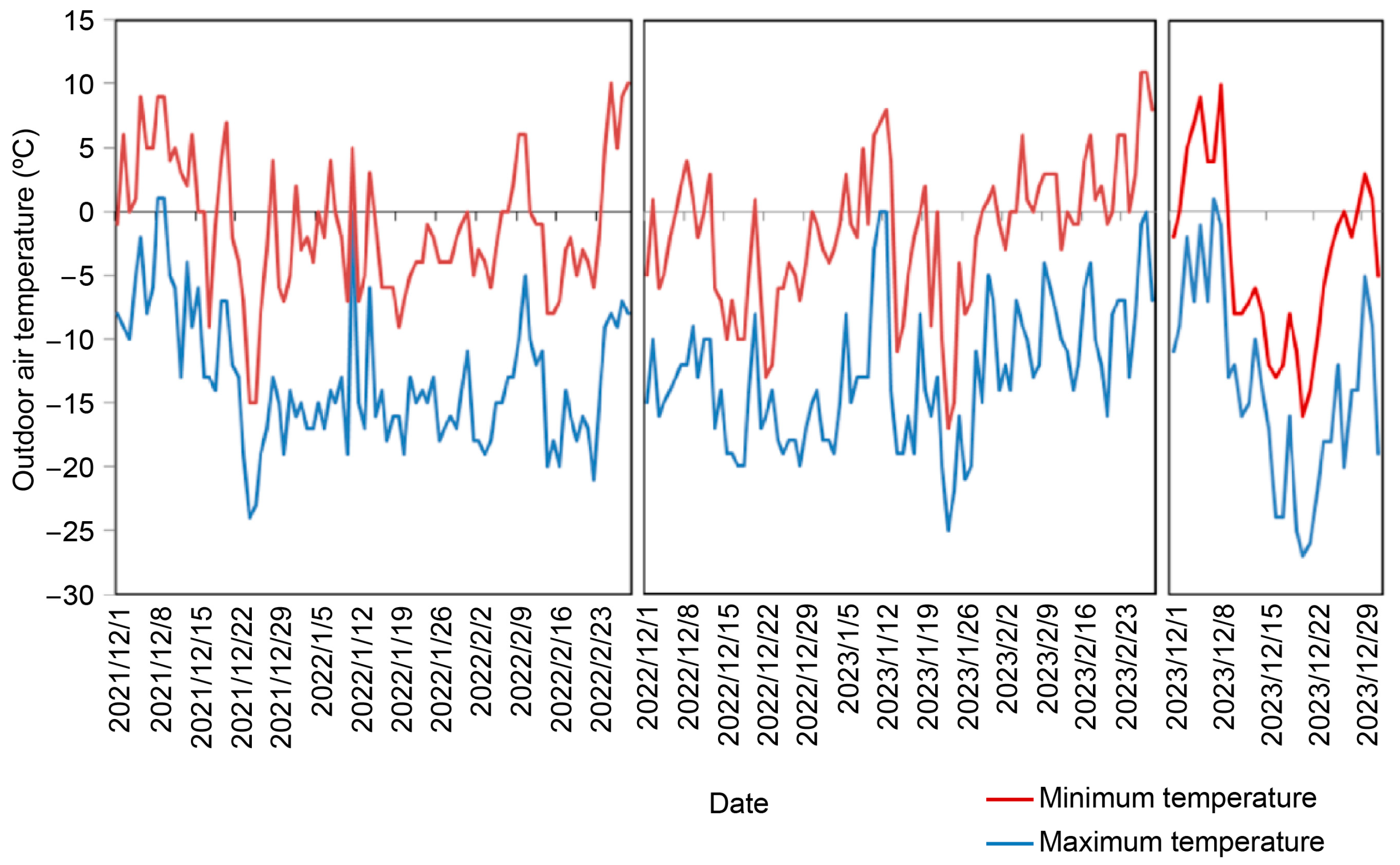
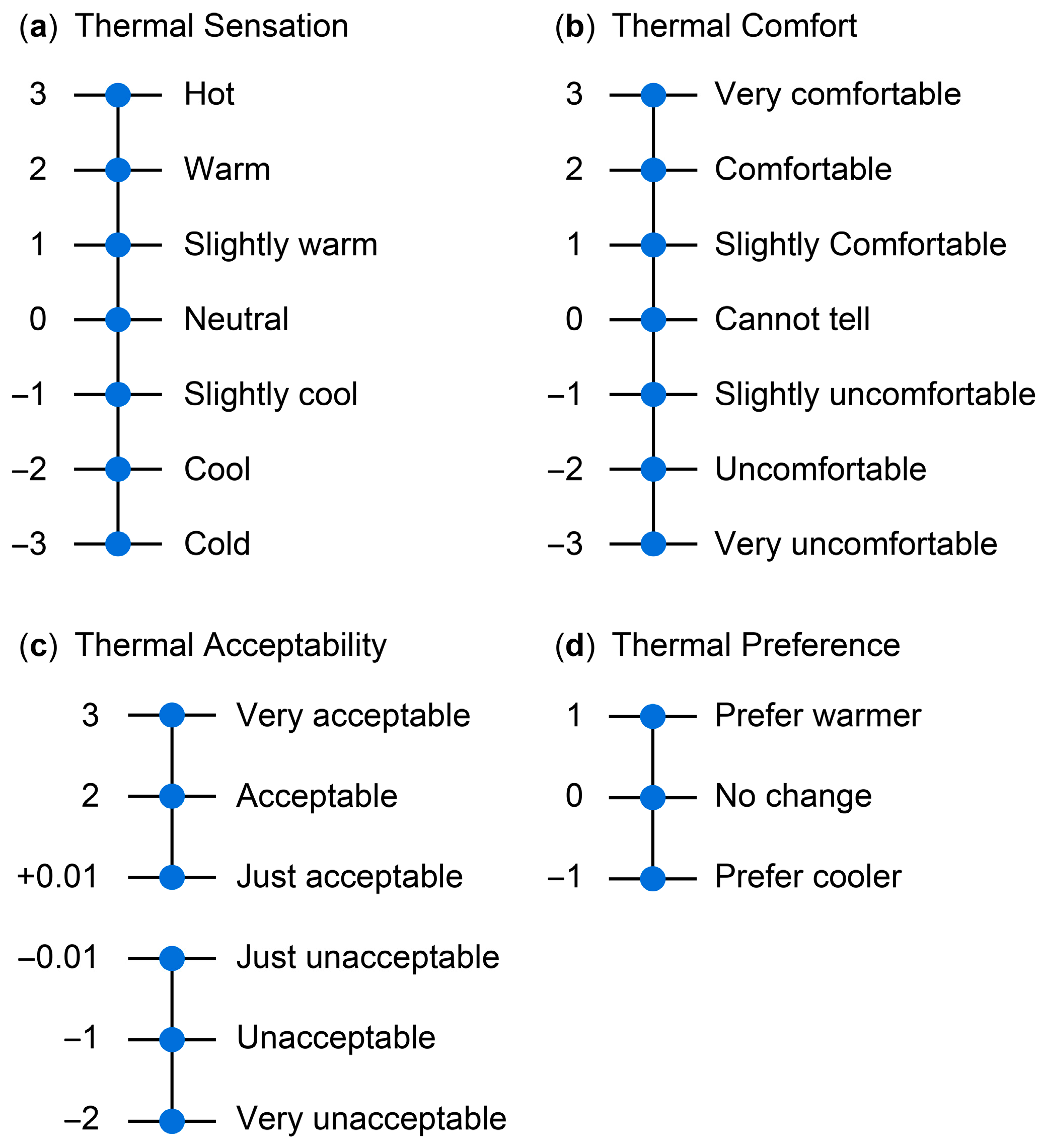


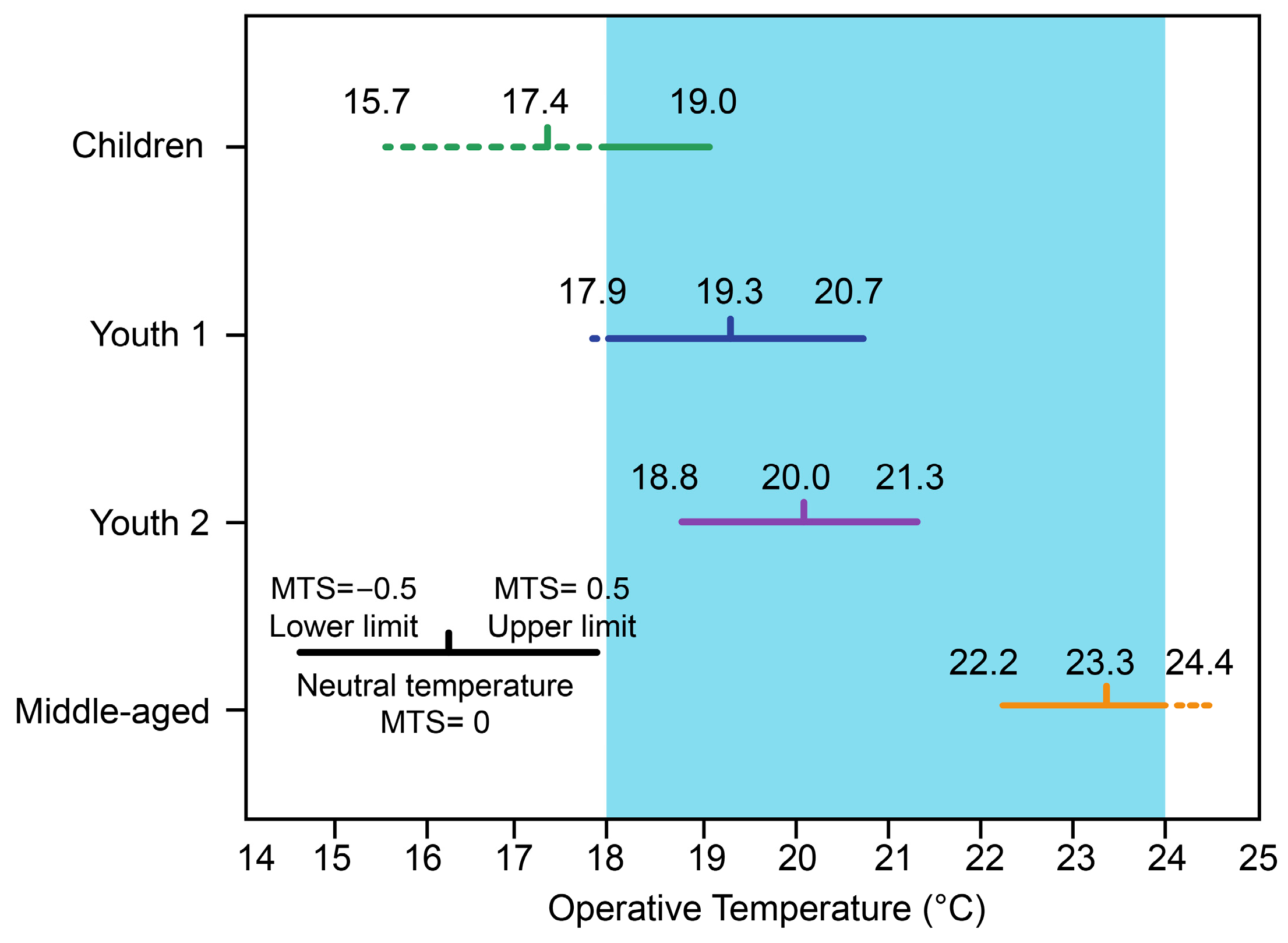
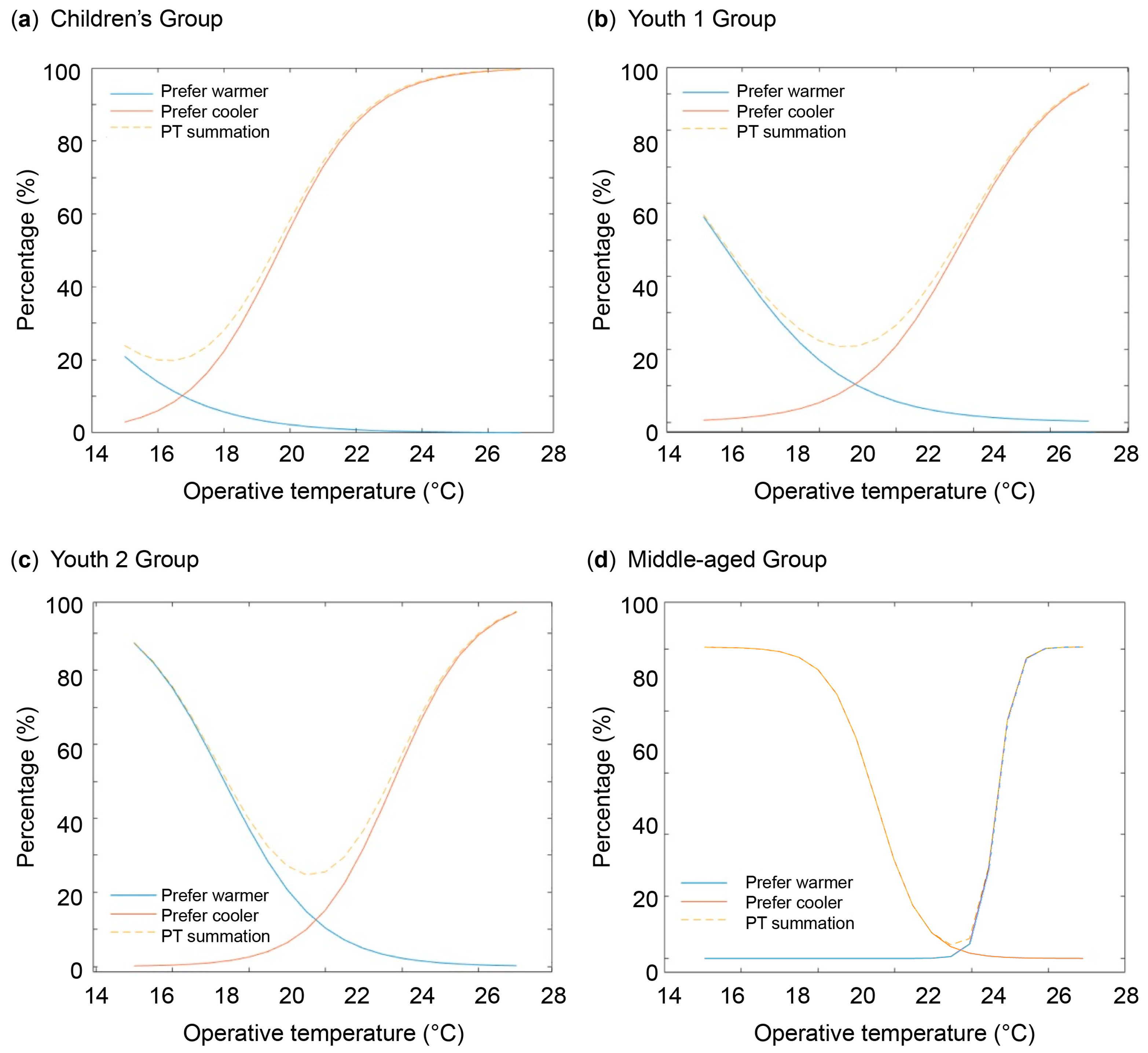
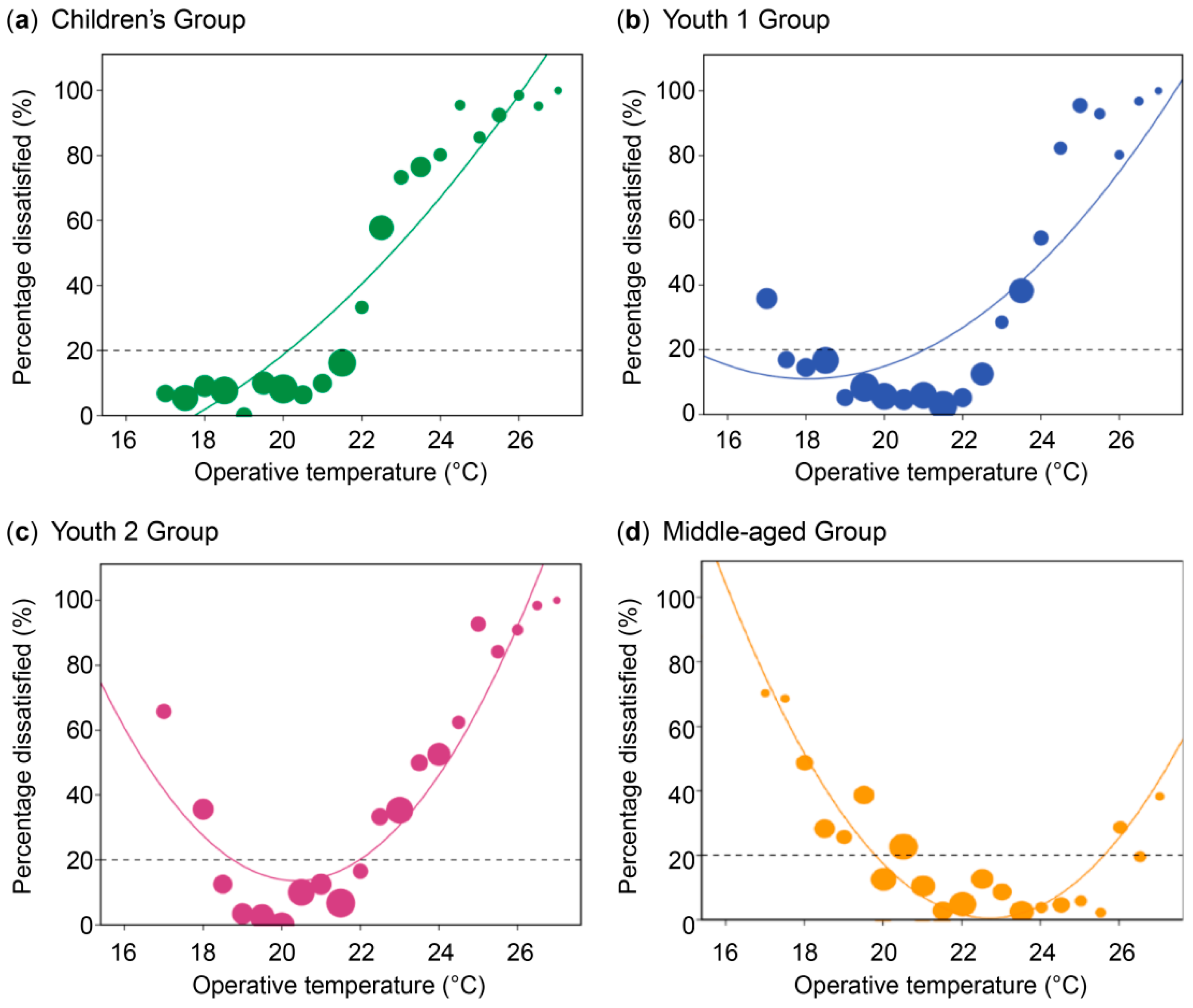


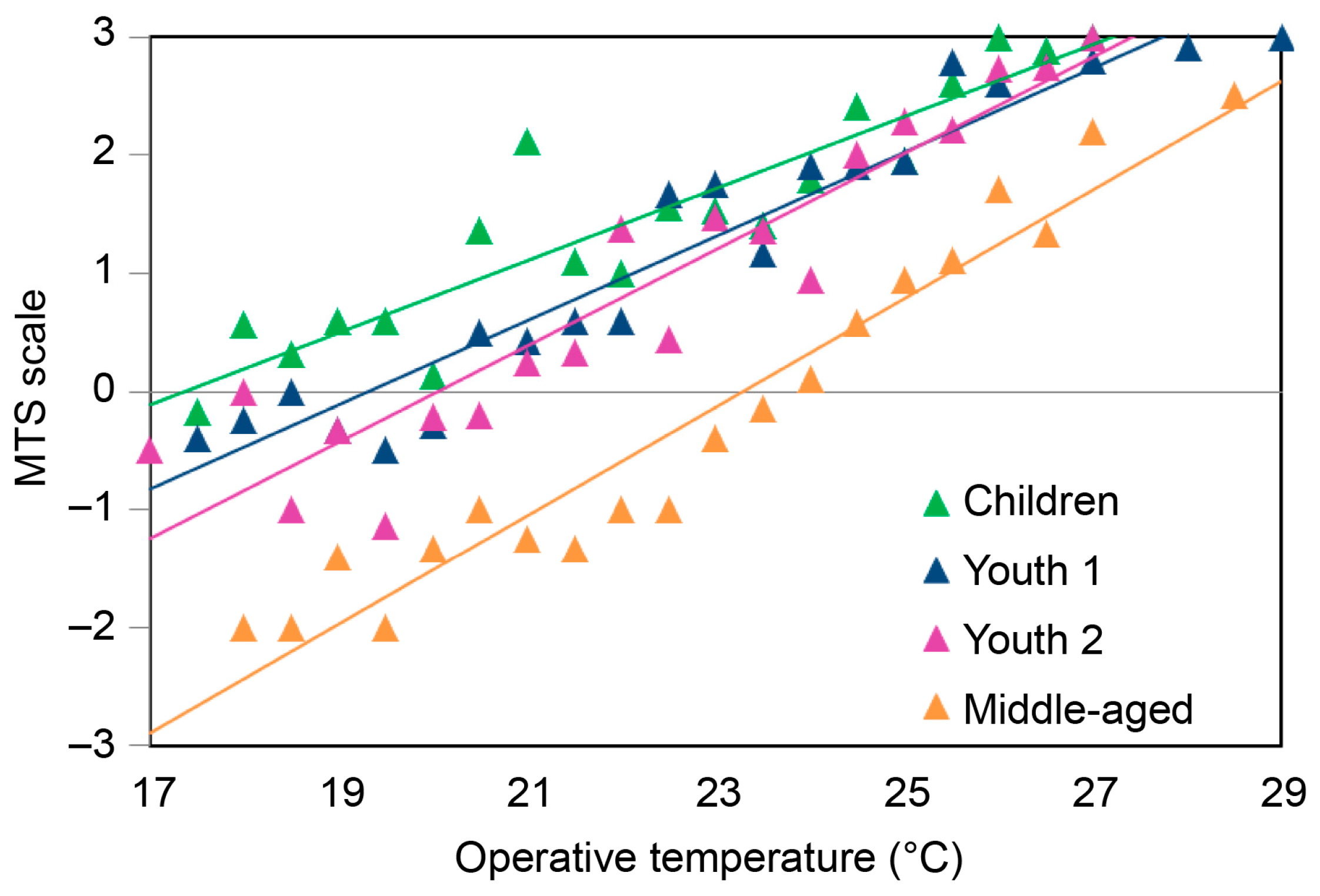
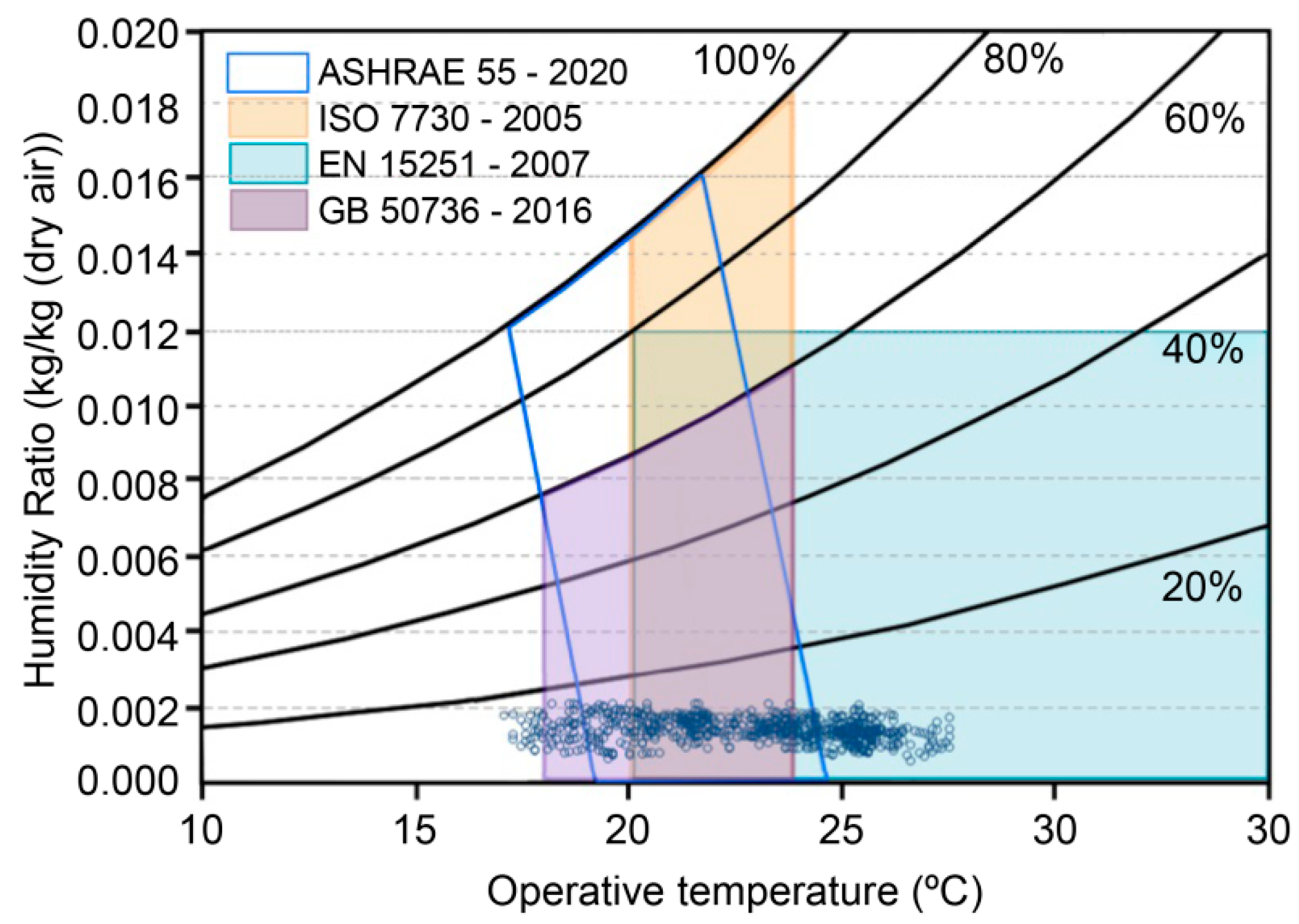
| Parameter | Equipment Model | Range | Accuracy | Equipment Picture |
|---|---|---|---|---|
| Host | JT2180 | — | — |  |
| Air Temperature (°C) | JT2180 | −20 to 85 °C | ±0.5 °C |  |
| Black Globe Temperature (°C) | JT2180 (50 mm) | −20 to 85 °C | ±0.5 °C |  |
| Air velocity (m·s−1) | JT2180 | 0.05–2.0 m/s 2.0–5.0 m/s | ±(0.05 m/s + 2%) ±(0.1 m/s ± 2%) |  |
| Relative Humidity (%) | JTR08 | 0–100 | ±1.5% RH |  |
| Age Group | Age Division (years) | No. of Samples | Height (cm) | Weight (kg) |
|---|---|---|---|---|
| Children | 0–12 | 452 | 131.1 ± 20.3 | 30.7 ± 10.6 |
| Youth 1 | 13–24 | 324 | 168.3 ± 12.2 | 58.2 ± 22.4 |
| Youth 2 | 25–44 | 424 | 171.3 ± 11.8 | 66.1 ± 22.8 |
| Middle-aged | 45–59 | 264 | 169.5 ± 11.5 | 67.3 ± 20.5 |
| (a) | |||||
| Name | Area (District) | Commercial Area (m2) | No. of Floors | No. of Shops | |
| Mall 1 | Dadong | 243,829 | Aboveground: 8 Belowground: 2 | 717 | |
| Mall 2 | Heping | 103,900 | Aboveground: 4 Belowground: 1 | 249 | |
| Mall 3 | Hunnan | 150,000 | Aboveground: 5 Belowground: 2 | 418 | |
| Mall 4 | Heping | 240,000 | Aboveground: 8 Belowground: 2 | 339 | |
| (b) | |||||
| Name | Retail (%) | Catering (%) | Children-Related (%) | Entertainment (%) | Life Services (%) |
| Mall 1 | 33.6 | 10.2 | 39.7 | 9.7 | 6.8 |
| Mall 2 | 44.3 | 40.2 | 0.0 | 14.0 | 1.5 |
| Mall 3 | 82.3 | 10.8 | 2.5 | 2.9 | 1.5 |
| Mall 4 | 81.4 | 5.7 | 11.2 | 1.0 | 0.7 |
| (c) | |||||
| Name | 0–12 (%) | 13–24 (%) | 25–44 (%) | 45–59 (%) | 60+ (%) |
| Mall 1 | 32.0 | 4.7 | 55.2 | 3.7 | 4.4 |
| Mall 2 | 2.7 | 61.4 | 31.7 | 3.7 | 0.6 |
| Mall 3 | 8.3 | 21.8 | 55.0 | 11.2 | 3.7 |
| Mall 4 | 3.4 | 16.0 | 30.9 | 39.7 | 10.0 |
| Parameter | Mean | Min. | Max. | Std. Dev. |
|---|---|---|---|---|
| Ta (°C) | 23.1 | 17.2 | 27.4 | 2.45 |
| Top (°C) | 23.8 | 17.4 | 29.5 | 2.93 |
| RH (%) | 16.5 | 10.0 | 22.5 | 2.65 |
| Va (m·s−1) | 0.10 | 0.01 | 0.24 | 0.04 |
| Clo (clo) | 1.22 | 0.75 | 1.68 | 0.16 |
| Respondent | Regression Equation for “Expect Cooler” | Regression Equation for “Expect Warmer” | PT (°C) |
|---|---|---|---|
| Children | 16.8 | ||
| Youth 1 | 20.9 | ||
| Youth 2 | 21.4 | ||
| Middle-aged | 24.5 |
| Age Group | Equation | 80% Acceptance Temperature Range (°C) |
|---|---|---|
| Children | (R2 = 0.8954) | ~20.1 |
| Youth 1 | (R2 = 0.8024) | 15.0~21.1 |
| Youth 2 | (R2 = 0.8728) | 18.8~21.9 |
| Middle-aged | (R2 = 0.7627) | 20.0~26.1 |
| Children | Youth 1 | Youth 2 | Middle-Aged | ||
|---|---|---|---|---|---|
| Temperature | Pearson’s correlation | −0.789 ** | −0.769 ** | −0.485 * | −0.403 |
| Sig. (2-tailed) | <0.001 | <0.001 | 0.030 | 0.078 |
| Author | Year | Location | Tn (°C) | 80% Acceptance Range (°C) |
|---|---|---|---|---|
| Liu et al. [8] | 2018 | Qingdao, China | 22.6 | ––– |
| Zhao et al. [12] | 2022 | Xi’an, China | 17.4 | 16.4–23.2 |
| Dang et al. [40] | 2017 | Beijing, China | 19.8 | 16.3–23.3 |
| Zhang et al. [44] | 2004 | Shenyang, China | 18.9 | 16.6–21.3 |
| Chen et al. [45] | 2022 | Beijing, China | Children: 20.1 Parents: 22.3 | Children: 16.7–23.4 Parents: 20.7–23.9 |
| Han [46] | 2015 | Shenyang, China | 19.1 | 17.3–20.8 |
| Simone et al. [47] | 2013 | Italy; France | 20.3 | 16.0–21.9 |
| Wang et al. [48] | 2022 | Handan, China | 22.1 | 17.7–27.3 |
| Ruina [49] | 2020 | Guangzhou, China | 23.6 | 18.8–26.3 |
| Ce [50] | 2013 | Harbin, China | 20.6 | 18.7–22.61 |
| Yun et al. [51] | 2014 | Seoul, Korea | 22.1 | ––– |
Disclaimer/Publisher’s Note: The statements, opinions and data contained in all publications are solely those of the individual author(s) and contributor(s) and not of MDPI and/or the editor(s). MDPI and/or the editor(s) disclaim responsibility for any injury to people or property resulting from any ideas, methods, instructions or products referred to in the content. |
© 2024 by the authors. Licensee MDPI, Basel, Switzerland. This article is an open access article distributed under the terms and conditions of the Creative Commons Attribution (CC BY) license (https://creativecommons.org/licenses/by/4.0/).
Share and Cite
Si, X.; Zhang, J.; Ma, M.; An, J.; Du, C.; Zhang, X.; Che, L. Sustainable Thermal Comfort by Age Group in Shopping Malls: Multi-Year Winter Surveys in a Severely Cold Region. Sustainability 2024, 16, 6563. https://doi.org/10.3390/su16156563
Si X, Zhang J, Ma M, An J, Du C, Zhang X, Che L. Sustainable Thermal Comfort by Age Group in Shopping Malls: Multi-Year Winter Surveys in a Severely Cold Region. Sustainability. 2024; 16(15):6563. https://doi.org/10.3390/su16156563
Chicago/Turabian StyleSi, Xiaomeng, Jiuhong Zhang, Mingxiao Ma, Jiang An, Chen Du, Xiaoqian Zhang, and Longxuan Che. 2024. "Sustainable Thermal Comfort by Age Group in Shopping Malls: Multi-Year Winter Surveys in a Severely Cold Region" Sustainability 16, no. 15: 6563. https://doi.org/10.3390/su16156563
APA StyleSi, X., Zhang, J., Ma, M., An, J., Du, C., Zhang, X., & Che, L. (2024). Sustainable Thermal Comfort by Age Group in Shopping Malls: Multi-Year Winter Surveys in a Severely Cold Region. Sustainability, 16(15), 6563. https://doi.org/10.3390/su16156563





